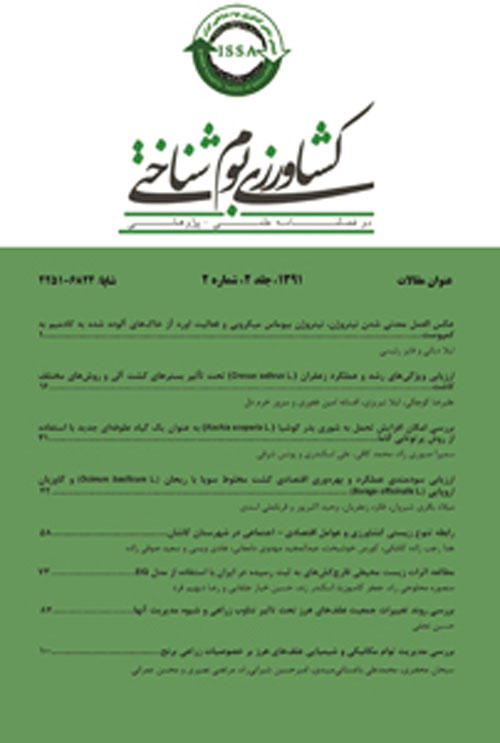Effect of species type and diversity on hay yield and erosion control and soil nutrients of hay in the suburbs of Urumia
Author(s):
Article Type:
Research/Original Article (دارای رتبه معتبر)
Abstract:
Introduction
In recent decades, erosion control, especially in rural pastures, has become one of the most important factors in retaining natural resources and increasing production. Increasing plant diversity increases the yield of forage, improves the sustainability of yield and reduces nutrient loss in the soil (Berendse et al, 2015). Diverse grasslands have more productive power. Some researchers point out that production and sustainability of ecosystems are not necessarily dependent on diversity, but also on the presence of key species and functional species (Guretzky et al., 2005). One way to prevent erosion is to create vegetation (Zuazo et al., 2008). This investigation has been conducted in order to survey the effects of planting 4 pasture plants with compositions of 1, 2, 3 and 4 plants.Materials And Methods
This experiment was conducted in the year 1395 in the area near Lake Urumia. The experiment was conducted in a randomized complete block design with 16 treatments in each replicate and a total of 48 test plots in three replications. The studied treatments were Arrhenatherum elatius, Agropyron trichophorum, Bromus inermis, Festuca arundinacea and combinations of two, three and four of these species. Measurements were taken in the second year of the experiment. Statistical analysis was performed using MSTAT-C software. Duncan's test was used at a 5% probability level to compare the means. Excel charts were used to draw graphs.Results And Discussion
Based on the results of this investigation, incorporating pasture plants in 3 and 4 compositions decreased erosion and runoff. Compositions with only 1 or 2 plants had less effect on erosion control. There were no significant differences between different plant compositions effect on hay yield, but the overall treatment of adding new plants did increase hay yield. All treatments of plant compositions affected the light interception rate by canopy. Based on results, the plantings increased the percentage of green area and the soil biological index, but decreased the contents of phosphorous, potash, and nitrogen and sodium. The highest nitrogen and phosphorus contents were observed in the 4*3*2*1 treatment and the highest potash was observed in the 3*2*1 and 4*2*1. The highest soil biological content was observed in the 4*3*2*1 treatment that was equivalent to a 73% increase in relation to biomass, canopy and soil nutrient. Similar results have been observed in the research of Idris et al. (2012) and Talaei et al. (2011).Conclusion
Considering the results, it seems that the planting of pasture plants, and especially the triaxial and quadruple planting of pasture plants, in addition to increasing the yield of fodder, also leads to good erosion control because of the improvements to soil characteristics.Language:
Persian
Published:
Journal of Agroecology, Volume:8 Issue: 1, 2018
Page:
75
https://magiran.com/p1846610
دانلود و مطالعه متن این مقاله با یکی از روشهای زیر امکان پذیر است:
اشتراک شخصی
با عضویت و پرداخت آنلاین حق اشتراک یکساله به مبلغ 1,390,000ريال میتوانید 70 عنوان مطلب دانلود کنید!
اشتراک سازمانی
به کتابخانه دانشگاه یا محل کار خود پیشنهاد کنید تا اشتراک سازمانی این پایگاه را برای دسترسی نامحدود همه کاربران به متن مطالب تهیه نمایند!
توجه!
- حق عضویت دریافتی صرف حمایت از نشریات عضو و نگهداری، تکمیل و توسعه مگیران میشود.
- پرداخت حق اشتراک و دانلود مقالات اجازه بازنشر آن در سایر رسانههای چاپی و دیجیتال را به کاربر نمیدهد.
In order to view content subscription is required
Personal subscription
Subscribe magiran.com for 70 € euros via PayPal and download 70 articles during a year.
Organization subscription
Please contact us to subscribe your university or library for unlimited access!


